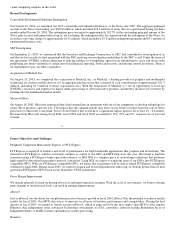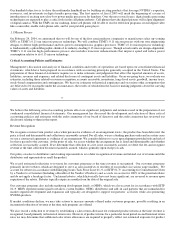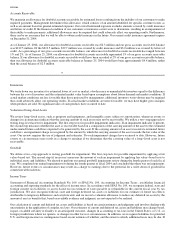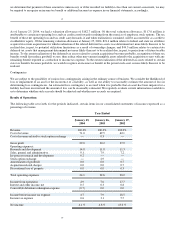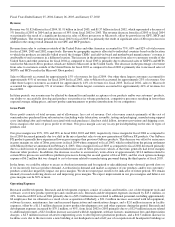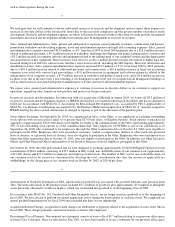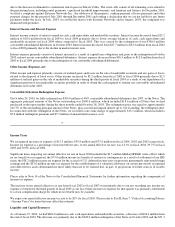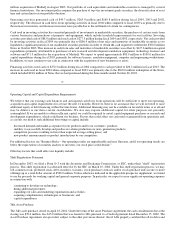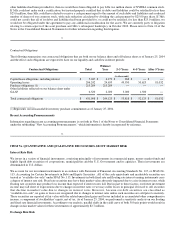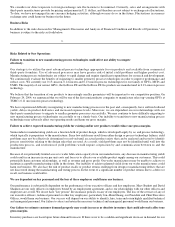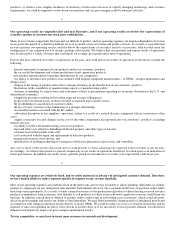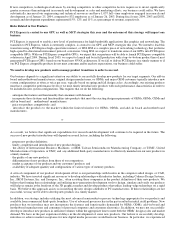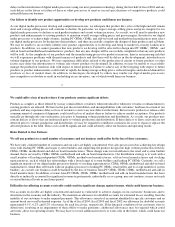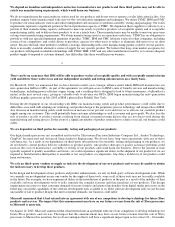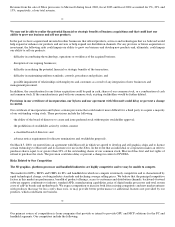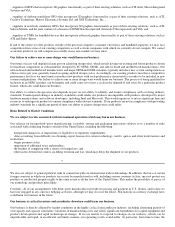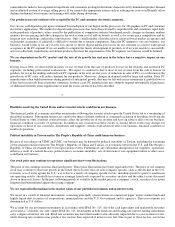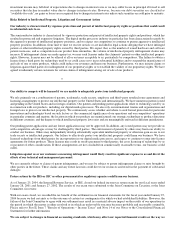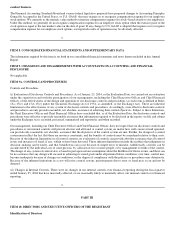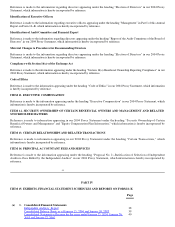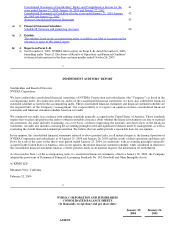NVIDIA 2004 Annual Report Download - page 24
Download and view the complete annual report
Please find page 24 of the 2004 NVIDIA annual report below. You can navigate through the pages in the report by either clicking on the pages listed below, or by using the keyword search tool below to find specific information within the annual report.
products, or if there were a higher incidence of inventory obsolescence because of rapidly changing technology and customer
requirements, we could be required to write−down our inventory and our gross margins could be adversely affected.
24
Our operating results are unpredictable and may fluctuate, and if our operating results are below the expectations of
securities analysts or investors our stock price could decline .
Many of our revenue components fluctuate and are difficult to predict, and our operating expenses are largely independent of revenue
in any particular period. It is therefore difficult for us to accurately forecast revenue and profits or losses. As a result, it is possible that
in some quarters our operating results could be below the expectations of securities analysts or investors, which could cause the
trading price of our common stock to decline, perhaps substantially. We believe that our quarterly and annual results of operations
may be affected by a variety of factors that could harm our revenue, gross profit and results of operations.
Factors that have affected our results of operations in the past, and could affect our results of operations in the future, include the
following:
· demand and market acceptance for our products and/or our customers’ products;
· the successful development and volume production of next−generation products;
· new product announcements or product introductions by our competitors;
· our ability to introduce new products in accordance with original equipment manufacturers’, or OEMs’, design requirements and
design cycles;
· changes in the timing of product orders due to unexpected delays in the introduction of our customers’ products;
· fluctuations in the availability of manufacturing capacity or manufacturing yields;
· declines in spending by corporations and consumers related to perceptions regarding an economic downturn in the U.S. and
international economies;
· competitive pressures resulting in lower than expected average selling prices;
· product rates of return in excess of that forecasted or expected due to quality issues;
· the rescheduling or cancellation of customer orders;
· the loss of a key customer or the termination of a strategic relationship;
· seasonal fluctuations associated with the PC market;
· substantial disruption in our suppliers’ operations, either as a result of a natural disaster, equipment failure, terrorism or other
cause;
· supply constraints for and changes in the cost of the other components incorporated into our customers’ products, including
memory devices;
· our ability to reduce the manufacturing costs of our products;
· legal and other costs related to defending intellectual property and other types of lawsuits;
· customer receivable bad debt write−offs;
· costs associated with the repair and replacement of defective products;
· unexpected inventory write−downs; and
· introductions of enabling technologies to keep pace with faster generations of processors and controllers.
Any one or more of the factors discussed above could prevent us from achieving our expected future revenue or net income.
Accordingly, we believe that period−to−period comparisons of our results of operations should not be relied upon as an indication of
future performance. In addition, the results of any quarterly period are not indicative of results to be expected for a full fiscal year.
25
Our operating expenses are relatively fixed, and we order materials in advance of anticipated customer demand. Therefore,
we have limited ability to reduce expenses quickly in response to any revenue shortfalls.
Most of our operating expenses are relatively fixed in the short term, and we may be unable to adjust spending sufficiently in a timely
manner to compensate for any unexpected sales shortfall. Substantially all of our sales are made on the basis of purchase orders rather
than long−term agreements. As a result, we may commit resources to the production of products without having received advance
purchase commitments from customers. Any inability to sell products to which we have devoted significant resources could harm our
business. In addition, cancellation or deferral of product orders could result in our holding excess inventory, which could adversely
affect our profit margins and restrict our ability to fund operations. We may build inventories during periods of anticipated growth and
in connection with selling workstation boards directly to major OEMs. We could be subject to excess or obsolete inventories and be
required to take corresponding inventory write−downs if growth slows or if we incorrectly forecast product demand. A reduction in
demand could negatively impact our gross margins and financial results.
To stay competitive, we may have to invest more resources in research and development.


